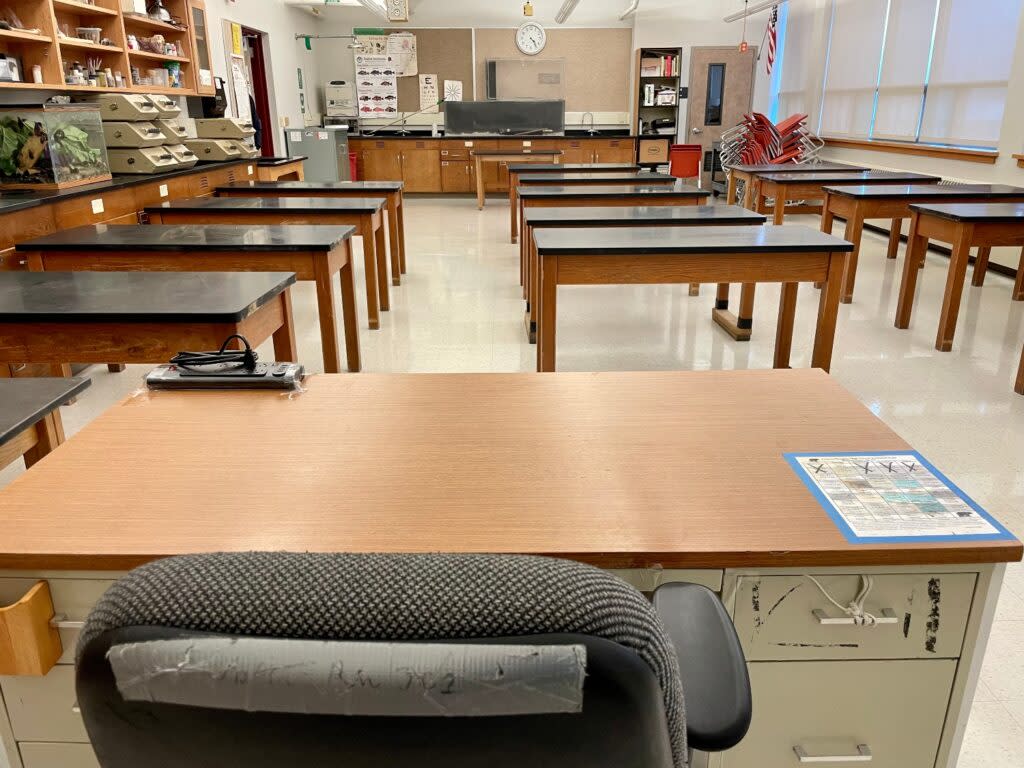Education funding standoff creates uncertainty as Alaska districts budget for next year

An empty classroom at Juneau-Douglas High School: Yadaa.at Kalé in Juneau, Alaska, on July 20, 2022. (Photo by Lisa Phu/Alaska Beacon)
As school districts are writing their budgets in preparation for the 12 months starting in July, a standoff between legislators and Gov. Mike Dunleavy leaves the amount of state funding they can expect to receive per pupil up in the air.
The districts that serve Alaska’s three largest cities have multimillion dollar budget deficits after years of flat funding for education, compounded by inflation and population loss.
If the state funded the recently passed Senate Bill 140, districts would have been able to plan on a $680 per student increase to the school funding formula. However, a veto threat from the governor has led to tremendous uncertainty — with jobs and school closures hanging in the balance — school board members and superintendents say.
“Why is he holding us hostage?” asked Juneau school board member Amber Frommherz. Her district is grappling with a nearly $10 million deficit and she said it needs to set a budget so it can notify school staff if they won’t have jobs next year. With the increase, few, if any, staff would lose jobs.
Yet the district is not including the funding increase in its budget because of the uncertainty: “We have experienced this year what happens when incorrect revenue assumptions are used to build a budget,” Superintendent Frank Hauser wrote parents in an email. “I am not going to present to the board a district budget based on revenue that I hope will be there, but on revenue that actually is.”
Frommherz said she doesn’t understand why the governor doesn’t sign a bill that would help the state keep sorely needed teachers. “We’re treading water — barely keeping our heads above water,” she said. “And he has a lifeline and he’s refusing to throw it.”
Dunleavy has said that it’s essential for the state to take more steps to increase the number of charter schools and to provide bonuses intended to recruit teachers and retain them for their first three years. He said he wouldn’t sign the per-student increase to the funding formula without the Legislature passing bills addressing charters and bonuses.
For the Fairbanks North Star Borough School District, the funding in the bill would mean an additional $8 million in the district, which faces a $28 million deficit. School Board President Brandy Harty said the district had considered raising class sizes and closing two schools, but the increase would mean only one school would close and class sizes could stay the same.
Harty acknowledged that as the state’s student population shrinks, the district must reduce its footprint, but said that hasty reductions — like three school closures in 2022 — proved traumatic in the region.
“Do we have time to be thoughtful about how we reduce the footprint of our district? Or do we have to close schools quickly, because we have no room to breathe?” she asked.
With a veto, Harty said the district would have to consider shortening the school year, essentially a furlough for employees. The board must approve its budget by March 19.
Harty said she wants to trust Dunleavy to not veto the funds, and to trust legislators to stand by their votes. “That’s a leap of faith that we’ve all been burned on just last year,” she said, referring to the governor’s veto of half to last year’s one-time funding increase for schools and the Legislature’s failure to override it. “We can’t trust them.”
The governor had not publicly committed to signing the increase last year. While 10 legislators who voted for the budget last year voted against overriding the governor’s veto, there wouldn’t have been enough votes for an override even if they had voted for it.
The Anchorage School District updated its budget last Tuesday, which is based on a bet that the funding increase to the BSA will be at least $110 per pupil. It averts some of the most drastic cuts the district considered, including dozens of jobs and its art program.
In Nome, Superintendent Jamie Burgess said the district is following SB140 with great interest. If the governor signs it, she won’t have to cut any positions next year —only a few positions that are currently vacant. But if he doesn’t, the district may cut anywhere from six to 11 jobs.
“Our teachers, of course, are demonstrably unhappy,” she said. “I don’t blame them at all. Nobody’s going to be excited about the prospect of not having a job.”
Burgess said that means larger classes and additional duties for the teachers that remain. And she said that even with the additional funding approved by legislators, her district will pull from its fund balance to finance operations, leaving it at an historic low. At the same time, the district will ask the city for more money than ever.
Dunleavy has until next Thursday, March 14, to sign the bill, veto it or let it become law without his signature.
GET THE MORNING HEADLINES DELIVERED TO YOUR INBOX
The post Education funding standoff creates uncertainty as Alaska districts budget for next year appeared first on Alaska Beacon.

